How to Get Testimonials From Clients (Email Scripts Included)
Before we discuss how to get testimonials from clients, we should examine why we should bother in the first place. If you’re cynical-minded, you might wonder if testimonials matter since businesses are only going to post glowing words from their clients and customers, right?
Here’s the thing: Even if our logical minds realize this, our emotional minds are still influenced by people’s experiences. And this is even more true on review sites like Yelp, Trustpilot, or Rotten Tomatoes.
Bottom line: Business testimonials and reviews serve as an important signal that the brand, service, or product is real and legit.
But I’m getting ahead of myself. 🙂
Below, I tackle the following questions. (Click on a link to jump directly to that section.)
- What are testimonials? Are they the same thing as reviews?
- Why do advertisers use testimonials?
- How to get testimonials from clients, how to get reviews from customers
- Example of a text testimonial request
- Example of an email testimonial request
- How to use customer testimonials
- Customer testimonial templates
- How to write a testimonial
Also, I can’t recommend this book enough: Using Behavioral Science in Marketing: Drive Customer Action and Loyalty by Prompting Instinctive Responses by Nancy Harhut. NOTE: It’s an Amazon affiliate link. As an Amazon Associate, I earn a small commission if you buy, but it won’t cost you more if you do. I own this book, and it’s incredibly insight, especially when it comes to things like social proof and customer testimonials.
What are testimonials? Are they the same thing as reviews?
A person gives “testimony” to the benefits they experienced using your products or services. People will sometimes use the words “testimonial” and “review” interchangeably.
Technically, business testimonials are usually managed by the business itself. The business asks its customers or clients to write testimonials via email and uses them in various marketing channels, like the website.
If the testimonial is less than positive, the business doesn’t have to post it. The business has editorial control over the content (like fixing typos or condensing the quote).
Reviews, on the other hand, are typically posted by the person writing them on places like Trustpilot, Yelp, Google, Amazon, Rotten Tomatoes—you get the idea.
Reviewers post the good, the bad, and the ugly. Barring something egregious that violates the platform’s policies, businesses don’t have much recourse for negative reviews aside from responding (which isn’t always a good idea—more on this in a moment).
Businesses can benefit from having both testimonials and reviews.
On the company website, the business can post testimonials it received directly from a client or customer. Reviews on places like the company’s Google Business Profile and Trustpilot happen organically.
However, it’s also not unusual for businesses to add a module to their site that draws in reviews from other sources, such as Amazon product pages (this is common in the B2C world).
For the purpose of the article, I’m primarily referring to business testimonials—the ones that the company directly asks its customers or clients to write. But I’ll touch on customer reviews, too.
Why do advertisers use testimonials?
Testimonials and reviews can be extremely persuasive, even for folks who pride themselves on being rational and logical.
It turns out that most of us don’t make buying decisions based on logic—at least, not in the beginning. We’re emotional creatures at heart, and emotions drive our decisions.
In her excellent book Using Behavioral Science in Marketing: Drive Customer Action and Loyalty by Prompting Instinctive Responses, Nancy Harhut says, “People decide based on emotional reasons—even really smart people, even in B2B.” (Note: The book link is an Amazon affiliate link; I’ll earn a small commission if you buy it.)
So even though our logical brain might point out that a business will only ever post positive testimonials on its site, our emotional brain doesn’t care. We need to hear about other people’s good experiences with the business, product, or service.
Why? We don’t want to make the wrong choice. Knowing that other people have already worked with this company or bought the product helps our brains feel comfortable with our decision to buy.
Think about it. Have you ever mentally crossed off a service provider from your list because it didn’t have many (or any) Google reviews? Or, as you debated between two similar products on Amazon, did you lean toward the one with more positive reviews? You’re not alone. That’s how it works.
We humans want to know we’re in good company and that other people have already tried and tested the product or service.
This concept is known as “social proof,” a psychological phenomenon in which people copy or are influenced by other people’s actions. It was coined by American psychologist Robert Cialdini in 1984 in his book Influence: Science and Practice. (The book link is an Amazon affiliate link. As an Amazon affiliate, I earn a small commission if you buy, but it won’t cost you more to do so.)
A good example that people of a certain age will likely remember is the “4 out of 5 dentists agree” testament that Trident used in its advertising. Who wouldn’t trust dentists about gum recommendations, right?
In the digital era, social proof like testimonials and reviews are important trust signals on long-form landing pages selling products or services.
Reviews help 90% of online shoppers make buying decisions. Next time you’re on Facebook or Instagram and you encounter an ad for something, click over to the landing page. I can almost guarantee two things: It will be a long scroll, and it will have reviews/testimonials sprinkled along the way.
Bottom line: Advertisers use testimonials because they understand we humans are influenced by other people’s experiences with the product or service.
How to get testimonials from clients. Plus, how to ask customers for reviews.
Here’s the thing: Asking people for testimonials and reviews isn’t a one-and-done task. Businesses should always ask customers and clients for reviews and testimonials.
For e-commerce, this process is often baked into the post-purchase workflow.
Anyone who’s bought something from Amazon has likely received one of these emails.
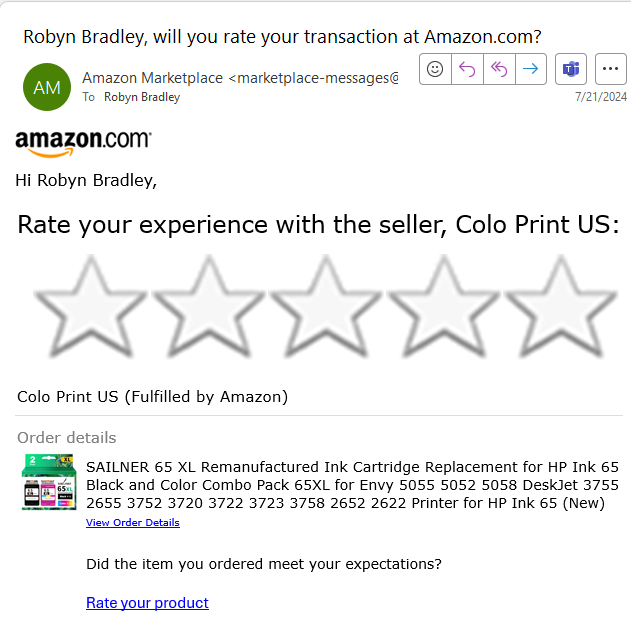
For other B2C businesses, following a multi-step process can help encourage more customer reviews:
- Verbal reminders: Encourage sales staff to deliver lines like, “If you liked our service/product, we welcome your reviews on places like Yelp and Google.”
- Visual reminders: For businesses with physical locations, have signage that reminds people that their feedback and reviews are welcome. You could include a QR code that people can scan with their phones and write a review. This can work well in places like hair salons, car dealerships, restaurants—you get the idea.
- Text reminders. One of the biggest challenges in getting people to give reviews is timing. Happy customers are usually very willing to talk about their experiences, but their good intentions can easily melt away if the review process is difficult. People are married to their phones, so sending texts with a link that brings people to the primary place you want a review (like Google) can improve conversion rates big time.
Here’s an example of a text testimonial request that I received. And yes, it did prompt me to write one right then and there.
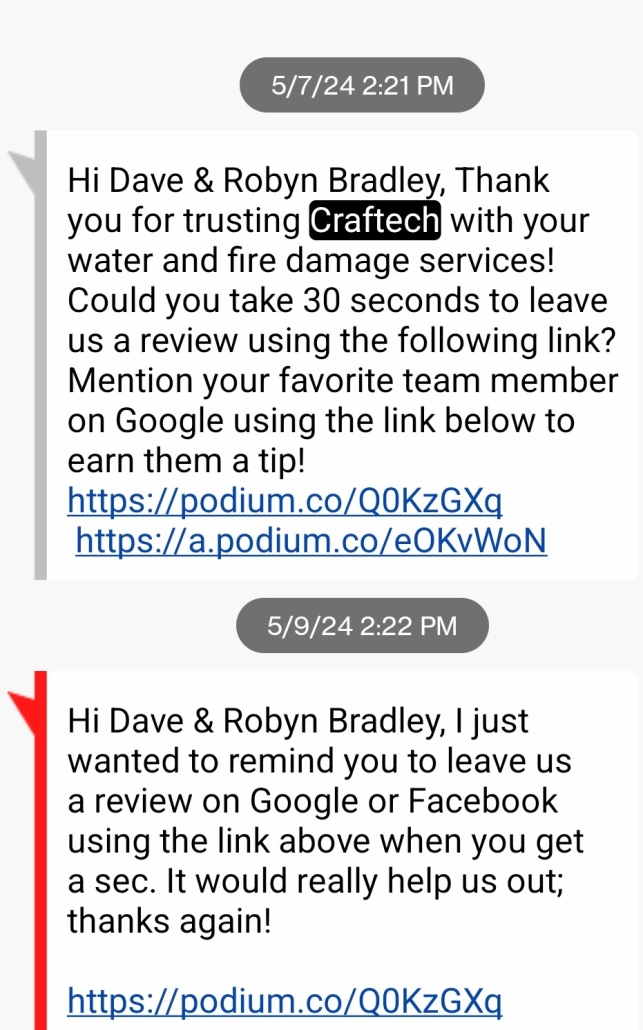
PRO TIP: Products called reputation management tools can help streamline the process.
Not all businesses necessarily have a presence on popular review sites like Yelp or even Google. Should they still solicit customer reviews? Short answer: YES.
My business is a perfect example. I’m a freelance copywriter. I work with small business owners, marketing agencies, and marketing managers within companies. I display customer testimonials on my site.
How to get testimonials from clients. Here’s my process:
When a client sends me an email and mentions how much they like my writing or working with me, I’ll respond with a “thank you for the kind words” and then ask if I can use their words in a testimonial for my website and other marketing materials.
If a client verbally expresses how much they like working with me—or something specific, like “You ask such good questions”—I’ll follow up with an email repeating what they said. Then, I’ll ask for permission to use their words as a testimonial.
I always give people the option to use their name or not (or a partial name, like “Jessica B.”)
Most people are fine with me using their name and title. Occasionally, they might need to get permission from their boss or the company’s legal department. That’s when things can go sideways. But in almost all cases, I can simply leave out the name and use something like “Marketing manager for a health and wellness company.”
If I know a client is happy with my work, I can also ask them to write me a LinkedIn Recommendation. I can then use the recommendation on my website.
How to request a testimonial from a client – real examples
Here’s an example of an email testimonial where I asked a client if I could use some of her kind words on my website.
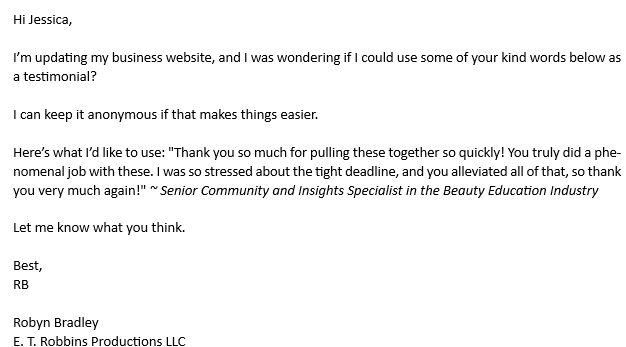
And here’s her response.

Don’t be afraid to give people direction. Here’s an example of me asking a client to write a testimonial about a specific skill.
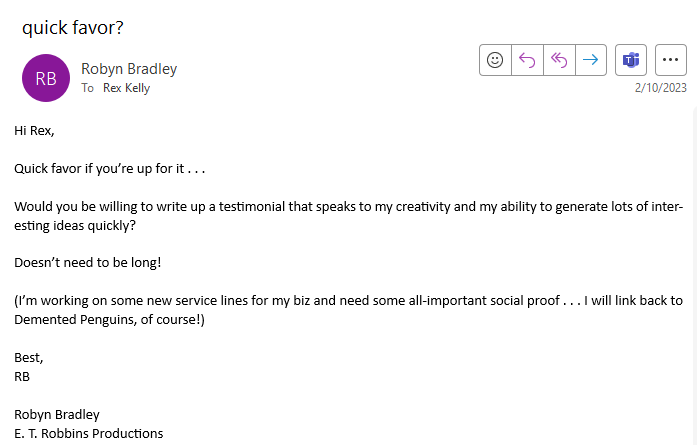
Here’s the result of that request.
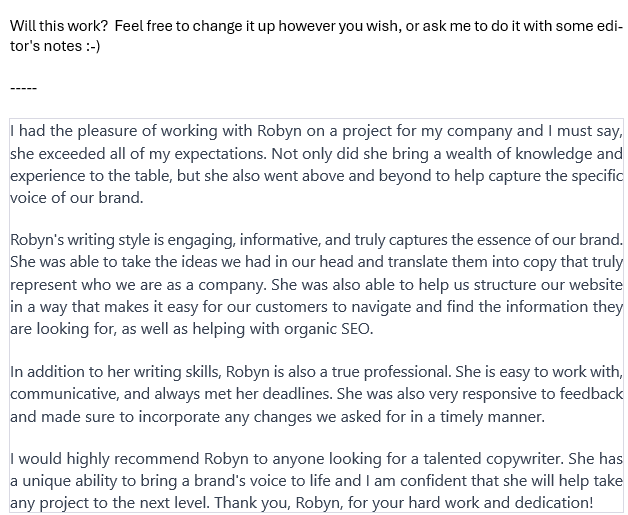
How to use customer testimonials
Don’t stockpile your customer testimonials into a “testimonials” page on your site and then forget about them. (It’s OK to have a repository, but not everyone will visit that page. Not to mention, a laundry list of quotes doesn’t make for riveting reading.) Instead, get as much mileage out of your testimonials as possible.
Here’s how to display testimonials on a website and beyond.
Website home page. Home pages tend to be the most trafficked pages. Having that all-important social proof in the form of a customer testimonial or review is essential. Here’s an example of one B2B business:
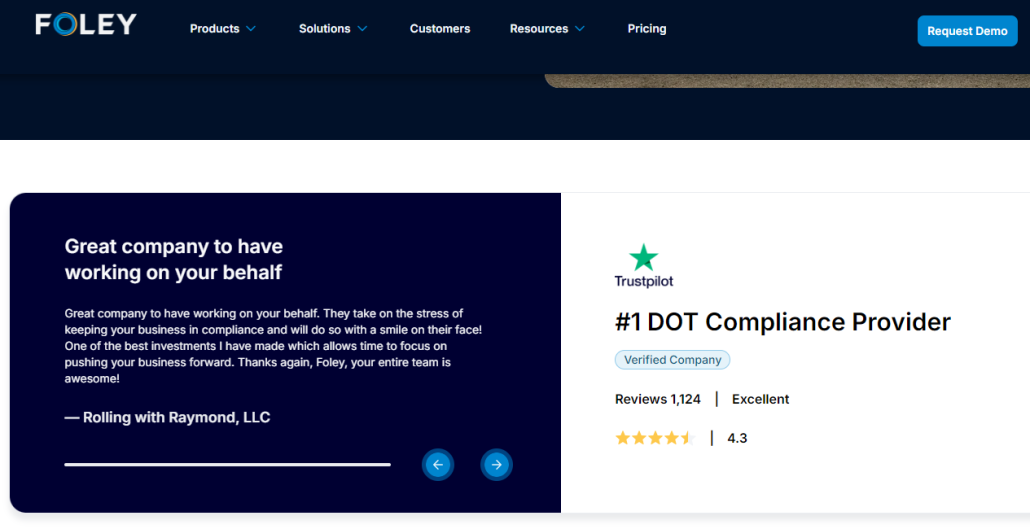
Service/product pages. Same idea. Social proof is essential. If you’re wondering how to display customer testimonials on your website, adding a review plug-in automates the process.
Landing pages for paid ads. If you run ads on places like Facebook or Instagram, think about where you’re sending people to. Those landing pages must look great and read well and convincingly—and the latter is where reviews come into play. Luckily, products exist that can help you create high-converting landing pages.
Contact pages. Reinforce how fabulous the company is and reassure the person who is about to make contact that they are indeed making a smart decision.
Team pages. If you have bio pages for employees and testimonials that speak directly to the employee, add a snippet of that review to the person’s bio. I write for a urology practice, and that’s the strategy we follow for doctor bios. Here’s an example.
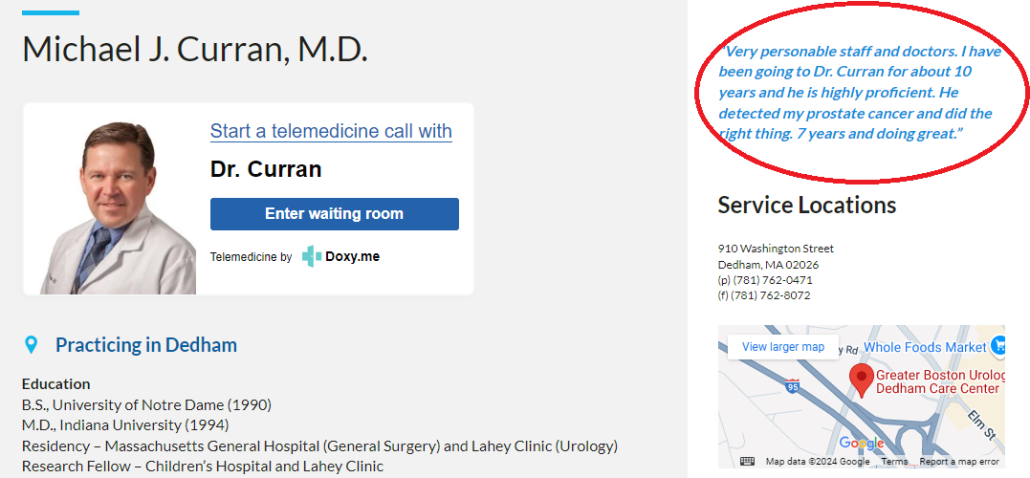
Social media. Have fun and get creative with how you share snippets of reviews. Here’s how one of my clients does it:
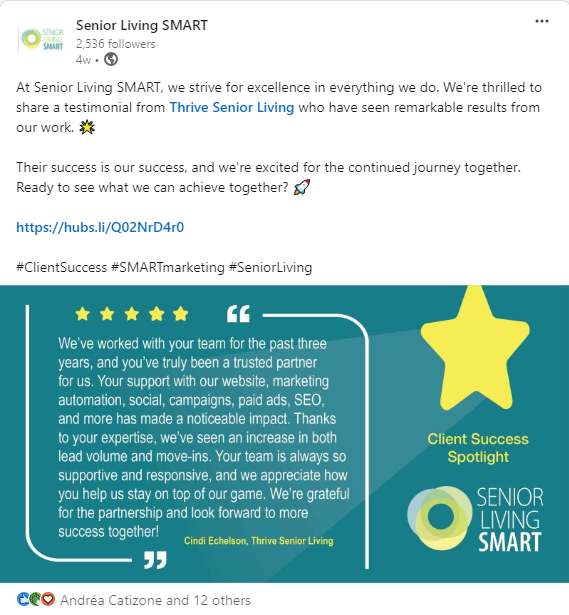
Corresponding case studies or customer stories. Using real quotes in case studies is what brings the narrative to life and makes it feel more real.
Lead nurturing emails. Businesses send nurturing emails to marketing-qualified leads (MQLs), people who are a good fit for the business’s product or service but are not ready to buy yet. Using short quotes from real customers can be a great way to prime MQLs for sales-qualified status.
Email signatures. Another way to increase the number of eyes on your reviews is to add a phrase from a stellar review or testimonial with a link to more reviews or testimonials.
Print collateral, like marketing brochures, print ads, and signage at events or in-store.
Product/service videos. You could do a video montage of reviews or highlight some of the more glowing reviews.
Asking for testimonials: tips, tricks, and pitfalls to avoid.
It never hurts to ask.
The worst that can happen is someone will decline (often due to legal reasons) or they never respond to your initial ask. I think it’s perfectly OK and fair to follow up once. (Emails get lost, and good intentions fall by the wayside.) But don’t hound. If someone doesn’t respond to your second request, move on. (And try not to take it personally. Easier said than done, I know.)
When you ask for a testimonial, make it easy for people to say yes.
Your approach will be different depending on the type of business you have. If you’re a solopreneur like me, you’ll likely email people with a request. That’s how I get 100% of my testimonials, and they’re usually based on something the client has said in an email.
I’ll piggyback on the email where they shared some nice words. I don’t revise—I want the words to sound authentic—but I’ll condense as needed or fix any obvious typos or glaring grammar errors.
Take advantage of marketing automation. This is especially important if you’re in retail, e-commerce, or some other B2C business. Automation can make it easy to send reminders to customers via text and email. Products might come with default messaging but always customize it.
Be careful about incentivizing reviews.
Have you ever been offered something in exchange for “an honest review”? Here’s one I got for a recent purchase.
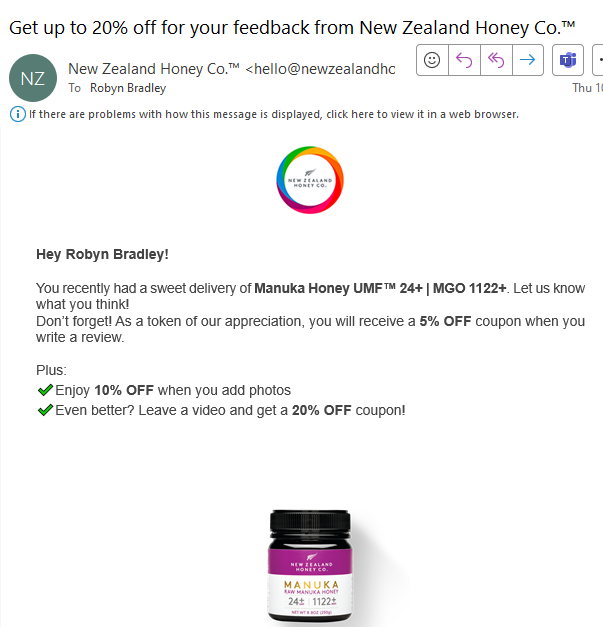
I have no doubt this company means well. (And they aren’t US-based.) But this can get tricky. Chances are someone who takes you up on it will be more inclined to write something positive, which is great for the business. But remember, people rely on authentic reviews to make their buying decisions.
The FTC has some good guidance around this. It says, “If you offer an incentive for a review, don’t condition it, explicitly or implicitly, on the review being positive. Even without that condition, the review should disclose the incentive, because its offer may introduce bias or change the weight and credibility that readers give the review.”
Never do anything deceptive, like pay for fake positive reviews. You also shouldn’t pay someone to write bad reviews about your competitors.
Customer testimonial templates
Here are some templates you can use.
Email template #1 for a client – this will work well if you work 1:1 with the client
Hi [NAME],
I’ve enjoyed our work together and appreciate the kind comments you’ve made along the way. Would you be willing to write a short testimonial that I can use on my website? It doesn’t need to be long at all—just a couple of lines would be great.
I can use your name and title or anonymize it if you prefer.
Let me know what you think.
##
Email template #2 for a client
Hi [NAME],
You recently sent an email with a lovely note about my work, and I was wondering if you’d be okay with me using the quote as a testimonial on my site.
Here’s what I’d like to use: [INSERT QUOTE + THE PERSON’S NAME, TITLE, COMPANY]
If you don’t want to use your full name or company name, I can anonymize it to this: [Example: Jessica B, marketing coordinator in the beauty and wellness industry]
Let me know what you think.
##
Ideas for automated messages requesting customer testimonials
Email subject line options:
- Let us know what you think
- Your opinion matters
- Tell others about your experience
- Care to share a review?
- Tell the world about us!
- Love us?! Tell people!
Body copy that could work for emails or texts
Hi [NAME]
Honest reviews help get the word out about our products/. They also help our team improve.
We’d love to know about your recent experience with us. Care to leave a short review?
Here’s a link to [Name the platform, like Google, Trustpilot, etc.]
How to write a testimonial
For a person: [Name] is a [adjective] [title]. She/he is especially skilled in x, y, and z. [Include final recommendation].
- In action: Robyn is a talented copywriter. She’s especially skilled in writing long-form content, snappy emails, and SEO website copy. I highly recommend her for any writing projects a small business might have.
For a business, service, product: [Business, service, product] is a [adjective] [category]. [Short explanation of your experience with the service/product.] Final recommendation.
- In action: Awesome Movers is the best moving company I’ve ever used. I’ve moved a lot over the last decade, and this company, hands down, has the best price and the most talented movers. They easily disassembled a complicated office desk and reassembled it in my new home office. Can’t recommend them enough.
How NOT to respond to a review – true story
Even though reviews can help (or hurt) a business, remember that they are first and foremost for prospective customers.
If you decide to respond to a review publicly, well—that response is public. Responding to less-than-stellar reviews in a way that doesn’t appear defensive or out of tune is challenging—if not downright impossible simply because people read things in different ways. You might think your tone is fair, but someone else reading it might think you sound defensive.
If you do respond to negative reviews, here are some things to think about.
Most platforms have protocols for flagging reviews that violate their policies. Carefully review the protocols and only flag a review if you’re 100 % certain the review violates the policy. Note: Someone leaving a strongly-worded negative review isn’t a good reason to flag it.
If you respond to someone who had a bad experience with your business, product, or service, sound human. Responses like “I’m sorry to hear about your experience” aren’t effective because you’re not apologizing for whatever the customer’s grievance is about. A response like that almost makes it sound like the person’s grievance is all in their head. And sure, it might be. But that’s just it. The review is from their point of view, their experience.
Don’t leave comments like “I’m sorry to hear this. We’d like to learn more about your experience. Please contact us to tell us more.” You might think that shows you’re being proactive, but you’re not. You’re putting it back on the customer to take the next step. And it’s even worse if you leave a phone number that leads to an automated main line. And it’s truly even worse if your responses to negative reviews are automated or you say the same thing in every review you respond to.
Want an example of how NOT to respond to negative reviews?
Check out the responses to the negative for this apartment complex.
And finally, here’s a “funny” experience that I had with a handyman. He kept bugging me to leave a review, which was surprising because we had a rough start to our engagement (he was always late, and one time, he blew up at my partner and me in a highly inappropriate manner). His work was OK enough, and because I’m a fellow business owner who gets how tough it can be out there sometimes, I wrote a four-star review (which was generous—I almost made it 3.5).
And guess what? He had the gall to question why we didn’t give him five stars. Yes, really.
See the text exchange below.
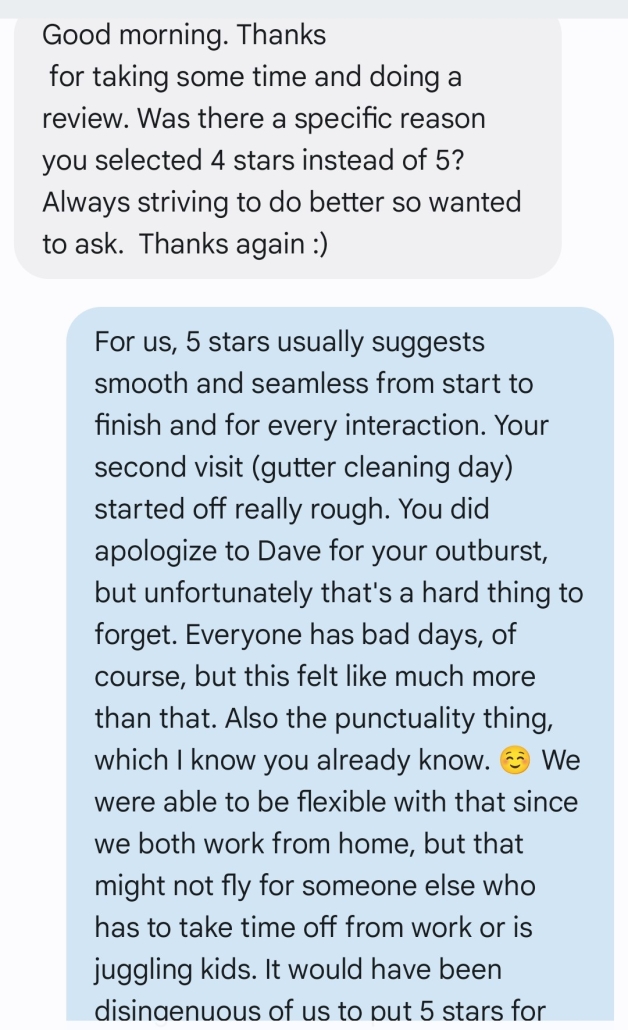
Obviously, don’t do something like that. 🙂
Bottom line: Getting customer testimonials and reviews is important to your business. But how you ask for reviews is also important.
Also, I can’t recommend this book enough: Using Behavioral Science in Marketing: Drive Customer Action and Loyalty by Prompting Instinctive Responses by Nancy Harhut. NOTE: It’s an Amazon affiliate link. As an Amazon Associate, I earn a small commission if you buy, but it won’t cost you more if you do. I own this book.
Got questions? Get in touch. If you’re interested in more topics like this, browse my blog or visit my YouTube channel.
